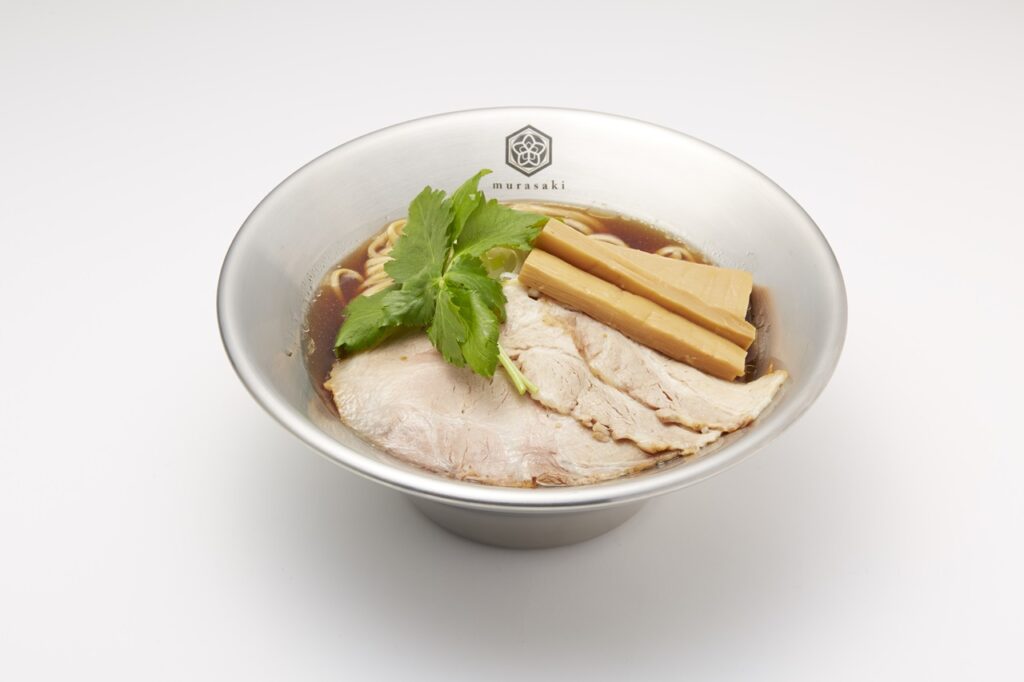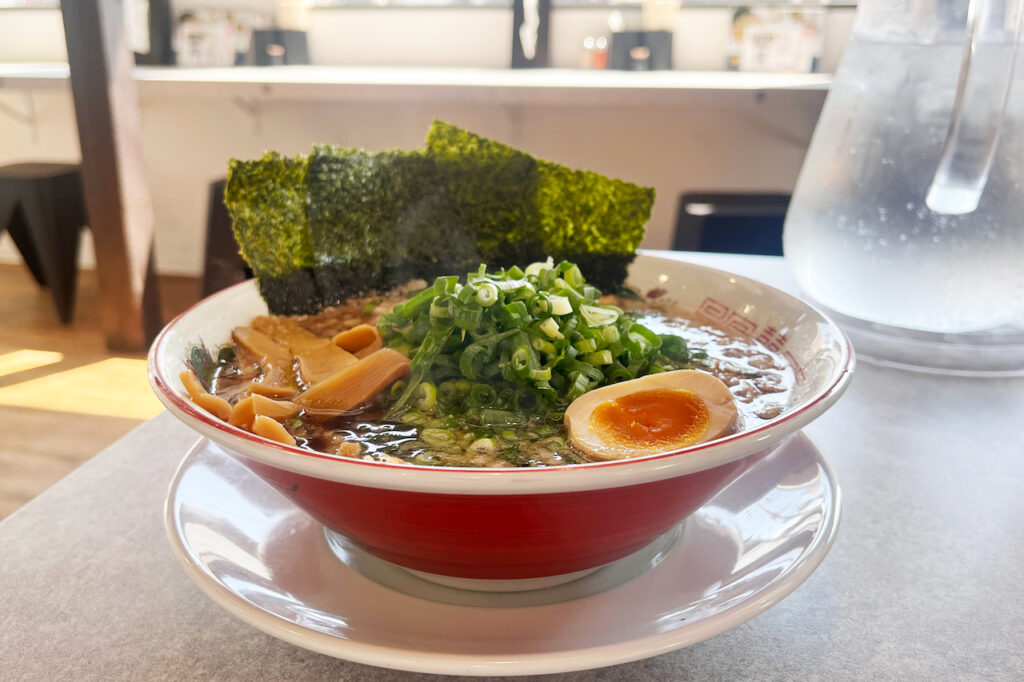
[2025]一度は行きたい!京都で人気の紅葉名所1...


[新福菜館 本店][貝だし麺 きた田][本家 第一旭 本店][麺匠 たか松 京都駅ビル拉麺小路店]など、京都駅から徒歩圏内にある人気のラーメン店を一挙にご紹介。行列必至の名店から一度は食べたい個性派ラーメンまで、店ごとに異なる至極の一杯が勢揃いする。激戦区である京都駅周辺のラーメンで、冷えた体を芯から温めよう。
※店舗名の前の数字は、おすすめ順やランキングではありません
Shinpuku Sankan started out as a Chinese noodle stall in 1938 and has since expanded nationwide. It is one of the most famous restaurants in the history of ramen in Kyoto. The main store is visited not only by locals but also by fans from all over the country, with lines forming from the time the store opens at 9:00 a.m. The distinctive feature of the ramen is the dark-colored Chinese noodle soup. The original soy sauce broth is simple but has a lingering taste that makes you want to eat it again and again. The fried rice, which has many fans, must be ordered together with the Chinese noodles.

中華そば(並)900円。中太ストレート麺にねぎ、モヤシ、チャーシューをトッピング。濃い色のスープだが意外とあっさり

RAMEN DATA
▶︎ Tare (Kaeshi) / Soy sauce
▶︎ soup/pork bone, chicken bones
▶︎ noodles/medium-thick straight noodles
Kaita Kaitamen opened in the Kyoto Station area in the fall of 2021, and is a ramen restaurant that is easy to enter even for a woman alone. The restaurant boasts of its shellfish broth called "shellfish white soup" made with a lot of shellfish and flat noodles made with Yumechikara, a Hokkaido wheat, to hold the soup together. It is also recommended to eat the lightly seasoned shellfish used in the soup with rice with the soup poured over the rice.

味玉入り貝だし麺1200円。アサリの旨みが味わいのベースとなり、ハマグリとホタテの上質な風味がスープに奥行きをもたらす

RAMEN DATA
▶︎タレ(かえし)/塩
▶︎ Soup/Shellfish broth
▶︎麺/細ストレート麺
戦後まもなくして誕生し、京都の玄関口で人々を出迎えてきた[本家 第一旭 本店]。早朝からできる行列は、京都の名物ともいえる。ラーメンは豚骨ベースの醤油味で、短時間で一気に炊いて旨みだけを抽出したスープに、複数の小麦粉をブレンドして熟成乾燥させた中太麺がよく合う。麺には[近藤製麺]、醤油には[五光醤油]と京都の老舗のものを厳選し、京都産の九条ねぎや緑豆モヤシをトッピング。まさに地元の美味しさを凝縮した一杯だ。

ラーメン980円。焼豚は中大貫と呼ばれる、脂と身のバランスが絶妙な豚肉のみを使用。のど越し爽快な麺は程良いもっちり感

RAMEN DATA
▶︎ Tare (Kaeshi) / Soy sauce
▶︎ soup/pork bone
▶︎ noodles/medium-thick straight noodles
This is a sister restaurant of the popular ramen restaurant "Menya Yuko," and has created its own unique ramen while inheriting the flavor of the popular ramen restaurant. They are particular about their soup arrangements, such as Madake, which has a stronger Japanese flavor with dried bonito flakes, and Kurochiku, which has the added flavor of mackerel, sardines, and bonito. The medium-thick noodles, which are made every morning in the restaurant's own noodle mill, are made with whole wheat flour and have a savory flavor and an impressive firmness that is as strong as the soup itself. Limited edition toppings such as hana-katsuo (dried bonito) and homemade spicy chives are also not to be missed.

真竹 MADAKE950円。時間を掛けて煮出した鶏ガラのスープに京都の老舗の醤油を合わせた、懐かしい味の醤油ラーメン

RAMEN DATA
▶︎ Tare (Kaeshi) / Soy sauce
▶︎ Soup/Shellfish broth
▶︎麺/中太麺
Kyoto Ramen Kenkyujo was opened in 2004 by the owner, Nobuo Tagawa, who wanted to "modernize the traditional Kyoto ramen". The main attraction of the ramen lineup is that it is unlike any other, including "ramen that won't make you thirsty," "ramen that has no foul smell," and "miso style ramen that doesn't use miso. The lab's painstaking attention to detail, which includes changing the soup and noodles for each menu item, raises expectations for the results of future research.

しょうゆとんこつラーメン950円。コクがありつつさっぱりとした味わいがまさに田川さんの求めた味。ストレート麺で

RAMEN DATA
▶︎ Tare (Kaeshi) / Soy sauce
▶︎ soup/pork bone
▶︎麺/細ストレート麺
京阪七条駅前の[ラーメンの坊歩]は、どこか懐かしさを漂わせながらも、ガラス張りで開放的な雰囲気。2人の店主が試行錯誤して完成させた鶏豚骨スープは、パンチが利いていてクセになる味わいだ。[夷川田ごと]の細めストレート麺とも相性抜群。鶏豚骨の他に、塩白湯、辛ニン、チャーシュー麺の4種類がある。ジューシーな唐揚げも人気のメニューで、飲んだ後のシメにもおすすめ。

チャーシュー麺1100円に+120 円で味玉をトッピング。しっとりとやわらかいレアチャーシューをうつわ一面にトッピングした大満足の一杯

RAMEN DATA
▶︎ Tare (Kaeshi) / Soy sauce
▶︎スープ/鶏、豚骨
▶︎麺/細ストレート麺
The owner, Mr. Aji, opened his restaurant out of his hobby of eating ramen. He makes ramen without chemical seasonings based on the concept of "ramen that can be eaten by the whole family. By slowly cooking pork bones and removing them at the best time, he creates a soup that looks as beautiful as miso soup. It is then topped with holo holo grilled pork, kujo leeks, and bean sprouts. This light and simple ramen, which does not use back fat, will fill your stomach and your heart.

ラーメン並 930円。超たっぷりの九条ねぎが麺とスープと合わさってキリっと締まった一杯。醤油、とんこつ、味噌から選択可能

RAMEN DATA
▶︎ Tare (Kaeshi) / Soy sauce
▶︎ soup/pork bone
▶︎麺/細麺
Kyoto Senmaru Shakariki] is known as a pioneer of Kyoto tsukemian. This store uses the sub-name [murasaki], which is associated with the noble color "kyomurasaki" and the precious "oshoyu" (soy sauce). The basic soup is made from broth made from dried Kyoto-style niboshi and chicken, with a homemade sauce made from aged shoyu. The noodles are custom-ordered from the long-established noodle factory in Kyoto, Men-ya He-e. After enjoying the live kitchen atmosphere at the counter, enjoy the Kyoto ramen filled with the delicious flavors of the mountains and the sea.

Shakariki standard ramen: 880 yen for a ramen seat. A wide variety of toppings are available, and the shi murasaki with a separate plate of all six toppings is 1,700 yen.

RAMEN DATA
▶︎タレ(かえし)/醬油
▶︎スープ/煮干、鶏
▶︎麺/細ストレート麺
Menya EDITION was opened with the ambition of "making the best back fat soy sauce ramen in Kyoto. The back fat soy sauce soup with condensed richness and flavor is perfectly balanced with Kondo Seimen's crispy aged noodles. Enjoy the ramen that is filled with love for Kyoto, including toppings such as Kujo green onions picked in the morning from farmers in Oharano and tender, marbled Tanba pork from Kyoto Kogenbuta.

Back Fat Soy Sauce Ramen - All on Top DX (regular size): 1,230 yen. A satisfying bowl of ramen with 3 sheets of nori, chashu pork, seasoned egg, pickled bamboo shoots, and kujo green onions.

RAMEN DATA
▶︎ Tare (Kaeshi) / Soy sauce
▶︎ soup/pork bone
▶︎ noodles/straight
[麺匠 たか松]本店で人気のつけ麺を[京都駅ビル]内で味わえるのが、こちら。そばのような褐色の特製麺には、長野県産石臼挽きの全粒粉を使用。つるっとしたのど越しの細麺と、鶏と魚介の旨みを抽出したつけ汁との相性は抜群だ。店内に掲示されたおすすめの食べ方を参考に、玉ねぎを入れたり、すだちや黒七味を掛けたりして味の変化を自由に楽しんで。

つけ麺(鶏魚介)並盛990円。“鶏×魚介”の濃厚なスープに、小麦の風味香る特製麺をたっぷり絡めて。※京都駅ビル拉麺小路店のみ販売価格が異なる

RAMEN DATA
▶︎ Tare (Kaeshi) / Soy sauce
▶︎ soup/chicken broth, seafood
▶︎ noodles/medium-thin straight noodles
正当派京都ラーメンの流れを受け継ぐ[らぁ~めん京]。[八坂神社]近くにある祇園本店と同じく、京都駅直結の京都駅ビル店でも伝統の味を楽しめる。店主が京都での修業の末に辿り着いた鶏白湯スープは、複雑ながらすっきりとした味わい。モチモチつるりとした口当たりの低温熟成細麺との相性は抜群。人気No.1の京らぁ~めんのほか、京都白味噌らぁ~めん、神様の中華そばなど多彩なメニュー展開で、何度訪れても新しい味に出合える。

京らぁ~めん930円(並)。阿波尾鶏と野菜の旨みを最大限に引き出した京都の鶏白湯は、最後の一滴まで飲み干したくなる

RAMEN DATA
▶︎タレ(かえし)/鶏白湯
▶︎ soup/chicken
▶︎麺/細麺 平打ちストレート
Todai, a ramen restaurant representing Tokushima ramen, has been a favorite among tourists and locals alike since it first appeared at Kyoto Ramen Koji in 2009. The rich tonkotsu (pork bone) soup is combined with a secret soy sauce sauce sauce and topped with sweet and spicy braised pork belly and bean sprouts to create a black Tokushima ramen. The meat is then dipped in a raw egg set on the table and served sukiyaki-style. The all-you-can-eat rice and raw egg is also a nice touch.

東大スペシャル1380円。甘辛い豚バラ肉がのった徳島ラーメンに、チャーシュー、煮玉子、メンマ、ねぎ、海苔を贅沢にトッピング

RAMEN DATA
▶︎ Tare (Kaeshi) / Soy sauce
▶︎ soup/pork bone
▶︎ noodles/straight
京都駅直結の京都駅ビルで、元祖泡系博多ラーメンが味わえる[博多一幸舎 京都拉麺小路店]。ベースは骨が砕けるまで炊き続けた濃厚な豚骨スープ。福岡の老舗蔵元[ヤマタカ醤油]の秘伝タレを合わせて、コクのある仕上がりに。博多の製麺所[製麺屋慶史]の平打ち細麺はしなやかなコシで、濃厚なスープとの相性は抜群。泡状スープとともに豚の旨みがふわりと広がり、クリーミィな口当たりがクセになること間違いなし。

Ajitama Negi Chashu-men (pork ramen with seasoned egg and green onions): 1,530 yen. The special chashu pork so big that it protrudes from the bowl and plenty of green onions make a big impact!

RAMEN DATA
▶︎タレ(かえし)/醤油、魚介だし
▶︎ soup/pork bone
▶︎ noodles/straight
1960(昭和35)年の創業以来、愛され続けている山形県のソウルフード。2023年の『ご当地ラーメン総選挙』ではグランプリを獲得した実力派で、1番人気の醤油ワンタンメンは、向こうが透けて見えるほど極薄皮のワンタンと魚介ベースに鶏やゲンコツなどの動物系だしを合わせた透き通ったスープが特徴で、コクや旨みを楽しむことができる。雲を呑むようなふわとろワンタンの口当たりを味わってみて。

醤油ワンタンメン 煮玉子入り1180円。トッピングが多く、満足度が高い一杯

RAMEN DATA
▶︎ Tare (Kaeshi) / Soy sauce
▶︎スープ/煮干し、丸鶏、げんこつ
▶︎麺/中細麺 やや縮れ
Menya Toratetsu is the favorite ramen restaurant of Hokkaido-area residents. The Kyoto Ramen Koji branch, the first of its kind to open in Kyoto, offers three types of miso ramen with rich individuality. The three different types of miso ramen, including spicy, savory, and matured miso and flavorful shrimp miso, are all rich in their own way. The thick, chewy noodles are a perfect match. The soup is also topped with a generous portion of "zangi," Hokkaido's fried chicken, in addition to chashu pork and boiled eggs.

Special Meat-packed Sapporo Aged Miso Ramen with Pork Belly Zangi ver. 1,550 yen. The large-sized pork belly Zangi on top makes this ramen the most popular ramen in terms of impact and volume!

RAMEN DATA
▶︎タレ(かえし)/味噌
▶︎スープ/白濁
▶︎麺/中太縮れ麺
大阪・高槻で愛されているラーメン店[中村商店]の塩ラーメンを京都で唯一味わえるのが、京都拉麺小路にある[中村商店 京都拉麺小路店]だ。看板メニューの金の塩は、澄みきった鶏清湯と魚介のWダシが特徴。大葉がふわりと香る淡麗な味わいに魅了され、足繁く通うファンも多い。他にも鶏の旨みが凝縮した泡系濃厚鶏白湯や、季節の限定ラーメンや京都限定ラーメンも見逃せない。

Gold salt with Ajitama (seasoned egg): 1,130 yen. A bowl of homemade noodles combined with a soup overflowing with flavor.

RAMEN DATA
▶︎タレ(かえし)/塩
▶︎スープ/鶏、魚介
▶︎麺/中細麺ストレート
京都駅ビルに店舗がある[ラーメンこがね家]は、全国のラーメンイベントでも注目される人気店。久留米の伝統である呼び戻し製法を守ったスープは、豚骨本来の深い旨みと濃厚なコクが特徴だ。ガツンと濃厚な豚骨スープに、ストレートの細麺がよく絡む。麺の硬さは普通から粉落としまで全5種類。チャーハンやチャーシュー丼など魅力的なサイドメニューも揃っているので、お腹を空かせて訪れてみて。

熟成とんこつラーメン焼豚2種盛味玉入980円。創業より継ぎ足しの熟成豚骨スープに、自慢の焼豚2種と味玉をトッピング

RAMEN DATA
▶︎タレ(かえし)/醤油、魚醤
▶︎ soup/pork bone
▶︎麺/細麺ストレート
Menke Iroha serves Toyama Black Ramen, a soy sauce ramen with a distinctive pitch-black visual appearance. Among the many black ramen stores in Toyama Prefecture, Iroha is known as a famous store that has made a name for itself at ramen shows and events. The soup, made of dark soy sauce and fish broth, has a surprisingly refreshing taste, and many people are surprised at the gap between the soup and its appearance. Paired with white rice, curry, or a bowl of pork mayo, it is sure to satisfy both the stomach and the soul.

京都店限定の九条ねぎブラックらーめん1230円。京の伝統野菜である九条ねぎをたっぷりトッピングしたブラックラーメン

RAMEN DATA
▶︎ Tare (Kaeshi) / Soy sauce
▶︎スープ/鶏、魚介
▶︎麺/縮れ中太麺
Over 600 interviews per year! An order site carefully selected by the editors who knows Kyoto and Shiga.
nowOfficial LINE friend registration500 yen OFF coupon is being issued!
Distributed every Friday morning at 8:00 am! From new restaurant information to event information that we want to share with you, We deliver articles about Kyoto that are useful to know. About 20,000 people have registered.Click here to add a friend!
 News
News Feature article
Feature article Featured event
Featured event